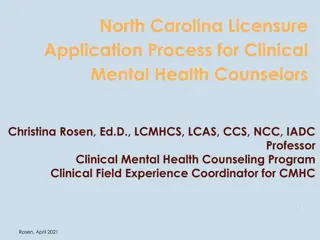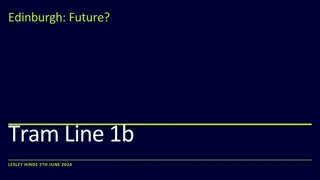Strategies for Reducing Vehicle Miles Traveled (VMT) in North Carolina
Explore the initiatives undertaken by NCDOT to reduce VMT in North Carolina through studies, toolkits, task forces, and collaboration with various stakeholders. Discover the importance of VMT reduction, its environmental and health benefits, commuter trends, and the impact of COVID-19 on transit ridership. Gain insights into pre-COVID VMT trends and Transportation Demand Management (TDM) strategies implemented in the state.
Download Presentation

Please find below an Image/Link to download the presentation.
The content on the website is provided AS IS for your information and personal use only. It may not be sold, licensed, or shared on other websites without obtaining consent from the author.If you encounter any issues during the download, it is possible that the publisher has removed the file from their server.
You are allowed to download the files provided on this website for personal or commercial use, subject to the condition that they are used lawfully. All files are the property of their respective owners.
The content on the website is provided AS IS for your information and personal use only. It may not be sold, licensed, or shared on other websites without obtaining consent from the author.
E N D
Presentation Transcript
NCDOT VMT Reduction Toolkit VMT Reduction October 31, 2022
Our charge: What s our charge? The terms of the Complete 540 Settlement agreement between NCDOT and the Southern Environmental Law Center include: NCDOT commits to hire a firm to conduct a study to identify strategies specific to North Carolina to reduce vehicle miles travelled ( VMT ) in urban, rural, and regional areas of the state. The study should be completed no more than a year from the date of the firm s hiring*. After the study is complete: NCDOT will create a toolkit for local governments and MPOs regarding VMT reduction strategies. This toolkit will include information regarding what actions are possible at what levels of government, what funding is available, and similar information. Within six months after the study is completed, NCDOT will establish a VMT reduction task force with members from the private sector, local governments, MPOs & RPOs, non-governmental organizations ( NGOs ), including CAC and SELC, and other interested parties, if any. *Study completed in April 2021 2
Why reduce VMT? What s our charge? Environmental/Health benefits Fewer automobile deaths More accessible society 3
2019 Commuter Mode, North Carolina vs US Commuter Trends NORTH CAROLINA UNITED STATES MEDIAN STATE/DISTRICT 1.2% 1.3% 1.8% 2.6% 0.5% 0.3% 1.4%2.6% 0.2% 1.4% 1.1% 5.0% 5.4% 6.7% 8.9% 5.7% 8.7% 8.9% 75.9% 78.5% 80.2% Drove Alone Worked at Home Taxi, motorcycle, or other Bicycle Carpool Public Transportation Walked Drove Alone Worked at Home Taxi, motorcycle, or other Bicycle Carpool Public Transportation Walked Drove Alone Worked at Home Taxi, motorcycle, or other Bicycle Carpool Public Transportation Walked 4 Source: BTS
Commuter Trends Transit Ridership During COVID-19 4-Week Rolling Average Ridership Compared to the same week in 2019 (pre-COVID), transit ridership in the 2nd week of August was: 59% lower in Charlotte 22% lower in the Triangle Region 700,000 600,000 Weekly Ridership 500,000 400,000 300,000 200,000 100,000 0 11/11/2017 12/16/2018 5/30/2018 1/20/2020 2/23/2021 9/11/2021 7/4/2019 8/7/2020 Charlotte GoRaleigh,GoTriangle,GoDurham Pandemic Begins Source: https://transitapp.com/apta 5
Pre-COVID-19 Annual VMT Trends: North Carolina vs USA VMT Trends 6 Source: FHWA, Office of Highway Policy Information
TDM Strategies 38 TDMs 8 categories 7 Primary 1 Support 7 Implemented exclusively by the state
TDM Strategies Pages include: Region Type Description Pros/Cons Potential VMT Reduction Impact Implementation Considerations Examples (NC and elsewhere) Sources Type of trip targeted (commuter, etc.) Who implements 8
Ranking Matrix TDM Strategies Matrix lists: Applicable regions Who Implements Trip purposes targeted Area targeted Approximate cost When results are seen Tech. advisory committee s ranking 9
Toolkit Template Toolkit Template An introduction on changing the focus of transportation planning away from car-centric projects Matrix summarizing the selected TDMs, including: Target areas (neighborhood, city, university, ) Target trip purpose (commuter, recreational, ) Expanded TDM Pages to include more details: Which entities can fund, implement, and support measures Potential obstacles Funding opportunities TDM measures that could support or improve performance of other TDM measures 10
Resources Resources VMT Reduction Study https://www.ncdot.gov/initiatives- policies/environmental/climate- change/Documents/vehicle-miles-traveled-reduction- study.pdf VMT Reduction Toolkit https://www.ncdot.gov/initiatives- policies/environmental/climate- change/Documents/vehicle-miles-traveled-reduction- study-tool-kit.pdf Heather Hildebrandt hjhildebrandt@ncdot.gov 11























